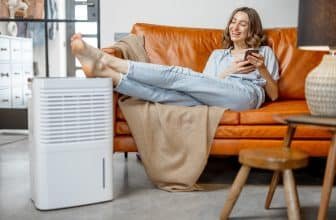Top Ionic Air Purifiers: Breathe Easy with the Latest in Clean Air Technology
Are ionic air purifiers the key to cleaner air in your space? These devices offer a balance of efficiency, low maintenance, and quiet operation, distinguishing them from conventional purifiers. Yet, potential health concerns, such as ozone emissions, warrant careful consideration. Our detailed exploration of ionic air purifiers covers how they work, their advantages, and how they measure up against other purifiers, ultimately spotlighting the top models for various needs without compromizing your well-being.
Key Takeaways
- Ionic air purifiers improve indoor air quality by using air ionizers or electrostatic precipitators to remove airborne contaminants such as dust, pollen, and allergens, and they require regular cleaning for optimal performance.
- Benefits of ionic air purifiers include low maintenance due to the absence of filters that need replacing, quiet operation, and energy efficiency, which makes them cost-effective and suitable for use in living spaces and bedrooms.
- Some ionic air purifiers may produce ozone, which can be harmful to health; consumers should choose models with low ozone emissions and pay attention to certifications indicating safety and compliance with regulatory standards.
Understanding Ionic Air Purifiers

ionic air purifiers, or ionic air cleaners, are technological marvels designed to keep our indoor air free from airborne contaminants. Using either electrostatic precipitators or air ionizers, these ionic air cleaner devices ensure the air in your room is as fresh as a breezy spring morning. But how exactly do they achieve this?
Air ionizers, also known as air ionizer devices, work by:
- Releasing negative ions into the air
- These ions stick to airborne contaminants like dust, pollen, smoke, and airborne allergens
- Making them heavy enough to fall onto nearby surfaces
- This leaves the air in your room cleaner and fresher than before.
Electrostatic precipitators work in a slightly different way. They use ionic filtration to attract charged particles within the purifier itself, leading to fresh and clean air.
Electrostatic Precipitators
Electrostatic precipitators utilize a powerful tool in the air purifying arsenal: electricity. They charge airborne particles, causing them to stick to collecting plates inside the purifier and resulting in cleaner room air. They are particularly effective against fine particulate matter such as ash, dust, and soot.
However, regular cleaning is imperative to maintain your purifier’s top-notch condition. The performance of your purifier can be affected by dirty collecting plates, resulting in less effective air cleaning. Remember, a well-maintained purifier is a high-performing purifier.
Air Ionizers
Air ionizers, also known as ion generators, emit negative ions into the air. These ions adhere to airborne particles, causing them to settle on surfaces. This process leads to their removal from the air and consequently cleaner indoor air.
Besides purifying the air, healthy negative ions also offer some additional benefits. They can help eliminate small particles, minimize odors, and alleviate allergy symptoms. So, while your room becomes cleaner, it also becomes a more pleasant place to be in.
Advantages of Ionic Air Purifiers
Aside from being effective at cleaning the air, ionic air purifiers also offer a host of other benefits. These include lower maintenance requirements, quiet operation, and energy efficiency, making them a worthy investment for any household.
Ionic air purifiers, compared to traditional HEPA filter-based purifiers, require less maintenance. This is because they don’t have filters that need regular replacement. This not only saves you time but also reduces maintenance costs in the long run.
Their operation is whisper quiet. Thanks to the lack of filters and motors, which are a common source of noise in other types of purifiers, you can enjoy clean air without any disturbing noise.
Their energy efficiency is also worth noting. With a power consumption typically ranging from 5 to 50 watts, they use less energy than traditional HEPA air purifiers.
Low Maintenance
Their low maintenance nature is one of the major selling points of ionic air purifiers. The benefits of their low maintenance include:
- No need to replace filters
- Fewer parts to worry about
- Less frequent maintenance tasks
- More savings in the long run
This offers a significant advantage over other air purifiers that rely on hepa filters, which require regular filter replacements. Not only does this save you money, but it also saves you precious time, which you can spend enjoying the fresh and clean air in your home.
Quiet Operation
The quiet operation of ionic air purifiers is one of their most underappreciated features. Thanks to their lack of filters and motors, they operate without the motor noise common in other types of air purifiers. This makes them an ideal choice for bedrooms and living spaces, where a quiet atmosphere is often desired.
Imagine waking up to clean, fresh air after a sound sleep, all thanks to your air purifier working silently in the background and removing airborne contaminants.
Energy Efficiency
With the world becoming increasingly eco-conscious, the importance of energy efficiency has never been higher. This is another area where ionic air purifiers excel. They typically consume between 5 and 50 watts of power, which is significantly lower than the power consumption of traditional HEPA air purifiers.
What does this mean for you? Lower energy bills, for one. But it also means a reduced carbon footprint, making ionic air purifiers a more environmentally friendly choice for air purification.
Addressing Ozone Concerns
While ionic air purifiers have many benefits, it’s important to address a common concern: ozone production. Some ionic air purifiers can produce ozone, which can pose significant health risks, especially for individuals with sensitive respiratory conditions. However, this doesn’t necessitate completely avoiding ionic air purifiers. Instead, it’s about choosing a safe model that produces low or even zero levels of ozone.
Indoor air pollution includes ozone, which is classified as a harmful component. Ozone can be a significant contributor to poor indoor air quality. It’s produced when air particles are electrically charged by the ionizers in the air purifiers. The key is to choose an ionic air purifier that emits less than 0.05 ppm of ozone, as per regulatory requirements.
Ozone Production
Ozone production is a crucial issue concerning ionic air purifiers. Some models, known as ozone generators, produce ozone as a byproduct of their operation, which can be harmful to both human health and the environment.
Inhaling ozone can cause the following symptoms and health effects:
- Irritation and inflammation of the respiratory system
- Coughing
- Chest tightness
- Shortness of breath
- Lung damage
- Exacerbation of asthma and heart disease symptoms
It’s also worth noting that ozone can react with other chemicals to create even more air pollutants.
Choosing a Safe Ionic Air Purifier
Despite the concerning risk of ozone production, it’s worth knowing that not all ionic air purifiers are the same. Some models are designed to produce low or even zero levels of ozone, making them a safe choice for your home.
When choosing an ionic air purifier, look for certifications that indicate low ozone emissions. You can also opt for models that have been tested and shown to have ozone levels well below the established standard, or no ozone emissions at all.
Top Ionic Air Purifier Models
Choosing the right ionic air purifier can be challenging given the multitude of options available on the market. We’ve done the homework for you and found some top models that stand out due to their unique features and benefits. These include BlueAir, Air Oasis, and Smart Air.
Each of these models has its own set of strengths:
- BlueAir uses a proprietary technology that combines electrostatic and mechanical filtration.
- Air Oasis offers a cost-effective solution with reduced energy consumption and no need for filter replacements.
- Smart Air focuses on providing affordable HEPA purifiers without ionizers, for effective particle capture without the potential drawbacks of ionization.
BlueAir

BlueAir ionic air purifiers are known for their proprietary HEPASilent™ technology, which combines electrostatic and mechanical filtration for efficient particle capture. What’s more, they also have an ionizer function that can increase the concentration of negative ions in your room by over 10 times, similar to the Sharper Image Ionic Breeze.
BlueAir’s commitment to reducing ozone levels is what truly distinguishes them. All their models have been lab tested and shown to effectively reduce ozone levels in the environment, making them a safe choice for your home.
Air Oasis
Air Oasis purifiers stand out for their use of advanced technologies such as UV light, AHPCO, and Bi-Polar ionization. These technologies work together to sterilize mold, bacteria, and viruses, while also reducing odors and preventing mold growth by neutralizing mold spores.
Moreover, Air Oasis purifiers offer the following benefits:
- Designed with a focus on long-term cost-effectiveness
- Consume less energy
- Don’t require filter replacements
- Ability to deactivate air contaminants instead of trapping them
These features make Air Oasis purifiers a unique choice among air purifiers, with lower operating costs in the long run.
Smart Air
Smart Air adopts a unique approach to air purification. Instead of using ionizers, they focus on providing affordable HEPA purifiers that effectively capture particles without the potential drawbacks of ionization.
But that’s not all. Smart Air purifiers also come equipped with modern features such as Wi-Fi connectivity, mobile apps, and voice control. This makes them not only effective at cleaning the air but also convenient and easy to use.
Proper Maintenance and Care
Regardless of the ionic air purifier you choose, its longevity and optimal performance depend on proper maintenance and care. This involves regular cleaning of the electrostatic plates and troubleshooting common issues.
Depending on the level of air pollution in your home, experts recommend cleaning the electrostatic plates anywhere from every two weeks to once a month. But maintenance goes beyond just cleaning—it also involves knowing how to troubleshoot common issues to ensure your purifier is always running at its best.
Cleaning Electrostatic Plates

The electrostatic plates in your ionic air purifier play a crucial role in capturing airborne particles. Therefore, regular cleaning of these plates is key to maintaining the effectiveness of your purifier.
Cleaning the plates is a relatively straightforward process. It involves wiping the plates with an aluminum-safe detergent or a mixture of isopropyl alcohol and deionized water. Just be sure to handle the plates carefully to avoid bending them and compromising the performance of your purifier.
Troubleshooting Common Issues
Like any piece of equipment, ionic air purifiers can sometimes encounter issues. But rest assured, most of these problems can be easily fixed with a bit of troubleshooting.
If your purifier is not working, here are some troubleshooting steps you can take:
- Check the power supply and cord for any defects.
- If the purifier is not generating air, check the filters and vents for any blockages.
- If you hear a loud noise, it might be due to a dirty or clogged filter or dust and debris build-up.
In all cases, the key is to familiarize yourself with your purifier and its manual so you can quickly identify and address any issues that arise.
Summary
Ionic air purifiers offer a host of benefits, from easy maintenance and quiet operation to energy efficiency and effective air purification. While there are concerns about ozone production, choosing a safe model such as BlueAir, Air Oasis, or Smart Air can mitigate this issue. Remember, proper maintenance and care are key to ensuring the longevity and optimal performance of your purifier. So breathe easy, knowing that you’re making a wise investment in your health and well-being.
Frequently Asked Questions
Do ionic air purifiers really work?
Ionic air purifiers are not the best option as they are not as effective as manufacturers claim and may contribute to harmful indoor air quality. Furthermore, ion generators may remove small particles but are relatively ineffective in removing large particles such as pollen and house dust allergens.
What are the side effects of ionic air purifiers?
Ionic air purifiers generate ozone, which can exacerbate allergies and asthma when inhaled, making them not entirely benign for human health and indoor air quality.
Which is better HEPA or ionic?
HEPA filter based media is the best technology for air cleaning, as it removes the most airborne contaminants and dangerous particulates.
What are the downsides of an ionizer?
Ionizers can produce harmful byproducts such as formaldehyde and ultrafine particles, which can be harmful when inhaled. Additionally, ion generators are ineffective in removing gases or odors, and may not effectively remove large particles like pollen and house dust allergens.
How do ionic air purifiers work?
Ionic air purifiers work by emitting negative ions into the air, which attach to airborne particles and remove them from the air.






